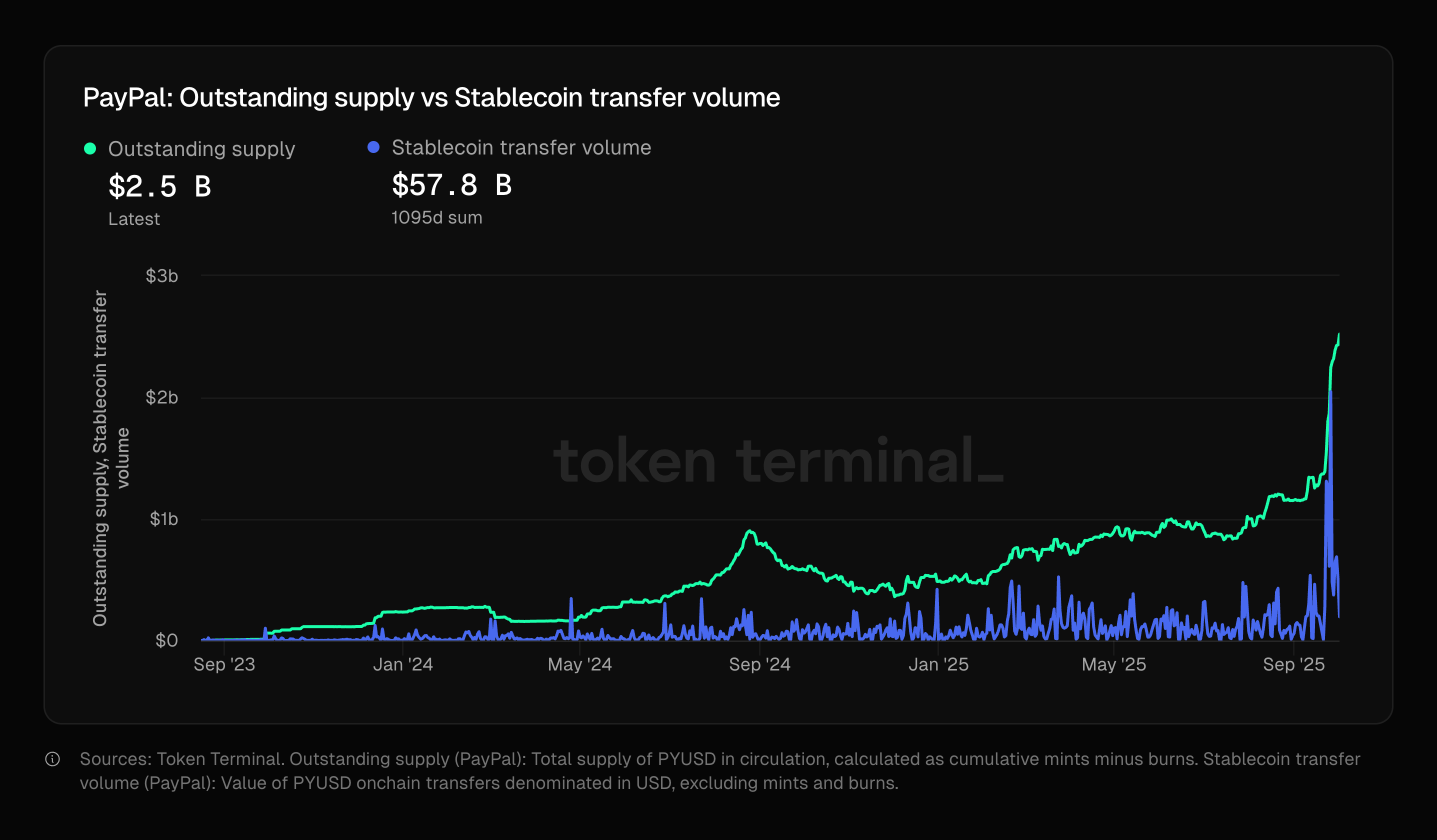PayPal’s PYUSD stablecoin supply doubles to $2.5b in a month
PayPal’s PYUSD supply has surged 113% month-over-month, hitting an all-time high of $2.54 billion.
- PayPal’s PYUSD stablecoin doubled its circulating supply, reaching $2.54 billion
- Over the past month, the token’s supply surged 113%
- USDT and USDC still dwarf all other stablecoins combined
PayPal’s stablecoin PYUSD has broken out of its quiet launch phase. On Friday, Oct. 3, the stablecoin reached an all-time high in circulating supply at $2.54 billion. Over the past month, this figure rose 113%. At the same time:
 PayPal’s PYUSD outstanding supply and stablecoin transfer volume | Source: Token Terminal
PayPal’s PYUSD outstanding supply and stablecoin transfer volume | Source: Token Terminal
A circulating supply of $2.54 billion puts PYUSD in seventh place among stablecoins, behind USDe, USDS, DAI, and USD1. Much of that supply, specifically $1.84 billion, is on Ethereum (ETH) . At the same time, $624 million worth of PYUSD is on Solana (SOL) .
PYUSD transfer volume peaked at $2 billion daily on Sept. 26, according to data from Token Terminal. So far, the stablecoin has facilitated almost $60 billion in total transfers. PYUSD has also reached a milestone of 40,000 holders, a figure that has risen consistently since January 2025.
Still, giants Tether and USDC continue to dominate the market, with $176 billion and $75.9 billion in circulating supply. Together, they account for almost 85% of all circulating supply. PYUSD itself accounts for 0.84% of the stablecoin market.
PYUSD stablecoin is taking off
At launch, many called the PYUSD stablecoin a “nothing burger” , citing its limited reach beyond the PayPal and Venmo ecosystem. Still, the firm has worked on decentralizing PYUSD, enabling users to send to external wallets and holding it non-custodially.
PYUSD’s all-time high coincided with the stablecoin market cap breaking the total value of $300 billion. U.S.-denominated stablecoins lead the charge, with USDC growing rapidly. What is more, the monthly stablecoin transfer volume reached $3.27 trillion.
Disclaimer: The content of this article solely reflects the author's opinion and does not represent the platform in any capacity. This article is not intended to serve as a reference for making investment decisions.
You may also like
Ethereum Updates: Major Ethereum Holder Moves Funds, Mirroring Pre-Surge Trends as Investors Watch for Market Steadiness
- A whale withdrew $82.9M in ETH from an exchange, sparking market bottoming speculation as exchange-held supply declines, a historical precursor to crypto rallies. - Analysts highlight "morning star" candlestick patterns and RSI resets on ETH charts, suggesting potential outperformance over Bitcoin and stabilization above key moving averages. - Resilient 30-day transaction volume and institutional accumulation signals contrast with ETF sell-off pressures, though $10,000 price targets face risks from U.S.
Zcash (ZEC) Price Rally as Privacy Coins Recover: Exploring the Drivers and Evaluating Long-Term Investment Potential
- Zcash (ZEC) surged over 7% in 24 hours after Cypherpunk Technologies' $58.88M institutional purchase, pushing prices to a $700+ multi-year high in late September 2025. - The firm's Zcash Digital Asset Treasury aims to accumulate 5% of ZEC supply, positioning it as a privacy-compliant alternative to fully anonymous coins like Monero amid tightening global crypto regulations. - Zcash's optional shielded transaction model using zk-SNARKs offers regulatory flexibility, attracting institutional backing from G
Sei (SEI) To Dip Further? This Key Fractal Setup Suggest So!

Crypto Marketing Faces a Turning Point: AI Automation Steers Through Complex Regulations
- Crypto marketing faces regulatory fragmentation, inefficient ad spend, and competition from tech giants, prompting demand for scalable solutions like Viant’s AI-driven white-label DSPs. - Viant’s AI tools automate 85% of ad spend and introduce "AI decisioning," targeting SMBs, while partnerships like Molson Coors boost CTV ad dominance. - Advocacy groups push for clearer crypto policies, and political shifts—like Trump’s "crypto-first" rhetoric—highlight tensions between innovation and regulatory safegua

